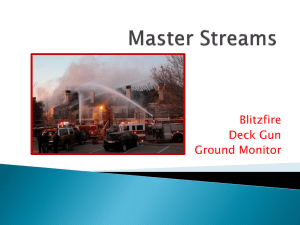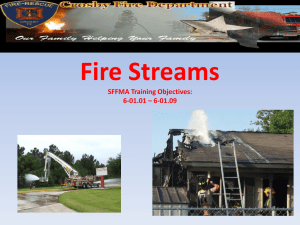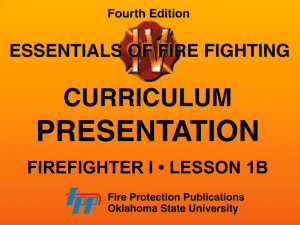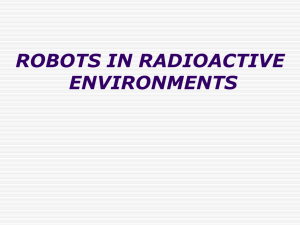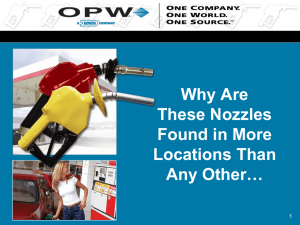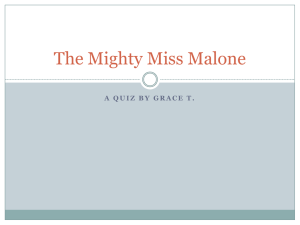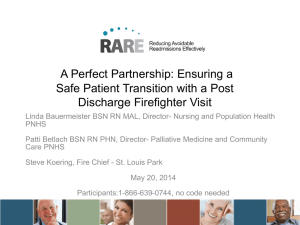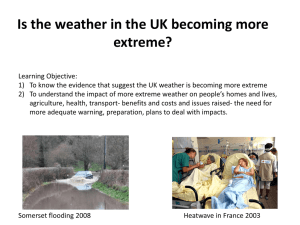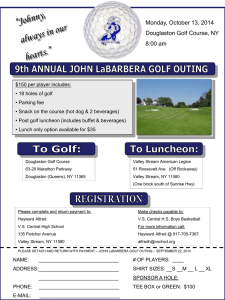Pump Operations I24.1
advertisement
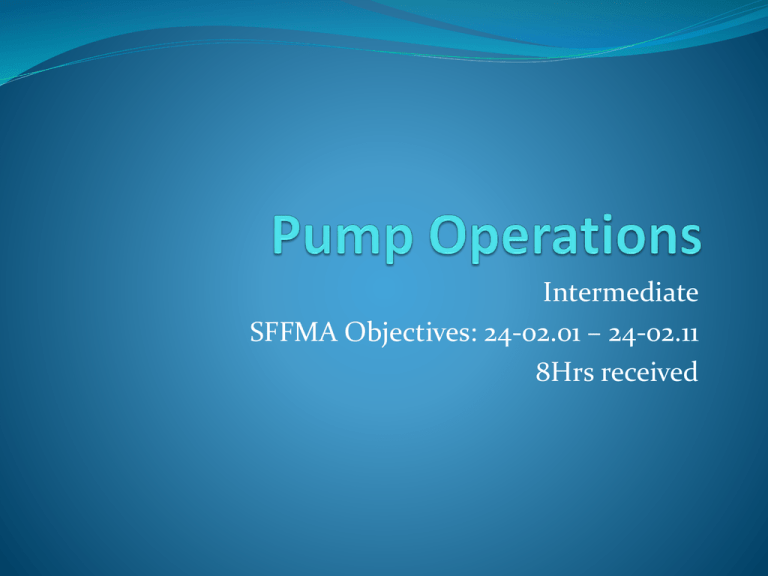
Intermediate SFFMA Objectives: 24-02.01 – 24-02.11 8Hrs received SFFMA Objectives 24-02.01 Trainee shall identify the type, design, operation, nozzle pressure and flow in GPM of various types of nozzles. 24-02.02 Trainee shall list the different types of fire streams. 24-02.03 Trainee, given a 2½ inch straight stream nozzle, shall demonstrate the proper opening and closing techniques and line movement procedures. 24-02.04 Trainee shall calculate nozzle reaction for various nozzle pressures. 24-02.05 Trainee, given the proper information, shall list advantages and disadvantages of various nozzles: A. straight stream B. fog C. master stream 24-02.06 Trainee shall define water hammer and list ways of preventing water hammer. 24-02.07 Trainee shall calculate the water flow rate needed to control fire in a room that is 20'x20'x 8'. 24-02.08 Trainee, given a diagram of various nozzles, shall list major parts and trace flow routes through each. 24-02.09 Trainee shall list factors that influence fire steams. 24-02.10 Trainee shall list the proper procedures for inspection and maintenance of fire fighting nozzles. 24-02.11 Trainee shall demonstrate the operations of the pumper pressure relief system and/or pressure control valve as follows: A. Trainee, given a pump panel, shall identify a pressure relief system. B. Trainee shall list the reasons a pressure relief system is used. C. Trainee shall list the different types of pressure relief systems used in the fire service. D. Trainee shall list three (3) reasons of how excessive pressure develops in fire hose. NOZZLE REACTION Counterforce directed against a person holding a nozzle or a device holding a nozzle by the velocity of water being discharged. Measured in pounds Nozzle reaction formulas NR= 1.57·d²·NP and NR= 0.0505·Q·NP Fire Stream Classifications Low-volume stream Handline stream Master stream Firefighter I 14–4 Fire Stream Considerations Volume discharged determined by design of nozzle, pressure at nozzle To be effective, stream must deliver volume of water sufficient to absorb heat faster than it is being generated (Continued) Firefighter I 14–5 Fire Stream Considerations Type of fire stream indicates specific pattern/shape of water stream Requirements of effective streams Requirements of all streams Firefighter I 14–6 Solid Stream Produced from fixed orifice, solid-bore nozzle Has ability to reach areas others might not; reach affected by several factors Design capabilities (Continued) Firefighter I 14–7 Solid Stream Velocity of stream a result of nozzle pressure Nozzle pressure, size of discharge opening determine flow Characteristics of effective fire streams Flow rate Firefighter I 14–8 Advantages of Solid Streams May maintain better interior visibility than others May have greater reach than others Operate at reduced nozzle pressures per gallon (liter) than others May be easier to maneuver (Continued) Firefighter I 14–9 Advantages of Solid Streams Have greater penetration power Less likely to disturb normal thermal layering of heat, gases during interior structural attacks Less prone to clogging with debris (Continued) Firefighter I 14–10 Advantages of Solid Streams Produce less steam conversion than fog nozzles Can be used to apply compressed-air foam Firefighter I 14–11 Disadvantages of Solid Streams Do not allow for different stream pattern selections Provide less heat absorption per gallon (liter) delivered than others Hoselines more easily kinked at corners, obstructions Firefighter I 14–12 DISCUSSION QUESTION What type of fire situation would be ideal for a solidstream nozzle? Firefighter I 14–13 Fog Stream Fine spray composed of tiny water droplets Design of most fog nozzles permits adjustment of tip to produce different stream patterns (Continued) Firefighter I 14–14 Fog Stream Water droplets formed to expose maximum water surface for heat absorption Desired performance of fog stream nozzles judged by amount of heat that fog stream absorbs and rate by which the water is converted into steam/vapor (Continued) Firefighter I 14–15 Fog Stream Nozzles permit settings of straight stream, narrow- angle fog, and wide-angle fog Nozzles should be operated at designed nozzle pressure (Continued) Firefighter I 14–16 Fog Stream Several factors affect reach of fog stream Interaction of these factors on fog stream results in fire stream with less reach than that of straight or solid stream (Continued) Firefighter I 14–17 Fog Stream Shorter reach makes fog streams less useful for outside, defensive fire fighting operations Well suited for fighting interior fires Firefighter I 14–18 Fog Stream: Waterflow Adjustment Two types of nozzles control rate of water flow through fog nozzle Manually adjustable nozzles Automatic nozzles Firefighter I 14–19 DISCUSSION QUESTION How should adjustments to the rate of flow be made? Firefighter I 14–20 Fog Stream: Nozzle Pressure Combination nozzles designed to operate at different pressures Designated operating pressure for most combination nozzles is 100 psi (700 kPa) (Continued) Firefighter I 14–21 Fog Stream: Nozzle Pressure Nozzles with other designated operating pressures available Setbacks of nozzles with lower operating pressures Courtesy of Elkhart Brass Manufacturing Company. Firefighter I 14–22 Advantages of Fog Streams Discharge pattern can be adjusted for situation Can aid ventilation Reduce heat by exposing maximum water surface for heat absorption Wide fog pattern provides protection to firefighters Firefighter I 14–23 DISCUSSION QUESTION What type of fire situation would be ideal for a fogstream nozzle? Firefighter I 14–24 Disadvantages of Fog Streams Do not have as much reach/penetrating power as solid streams More affected by wind than solid streams May disturb thermal layering May push air into fire area, intensifying the fire Firefighter I 14–25 Water Hammer Water moving through a pipe or hose has both weight and velocity. The weight of water increases as the pipe or hose size increases. Suddenly stopping water moving through a hose or pipe results in an energy surge being transmitted in the opposite direction, often at many times the original pressure. This surge is called Water Hammer WATER HAMMER Force created by the rapid acceleration or deceleration of water. It generally results from closing a valve or nozzle too quickly. Can be up to seven (7) times the original pressure. GAUGES Master Intake gauge (Compound) Master Discharge gauge Discharge gauge (individual gauges) Oil Pressure Voltmeter Tachometer (engine RPM) Pump overheat indicator Engine coolant temperature gauge Master Intake Gauge Measures positive or negative pressure Calibrated from 0 to 600 PSI (usually) for positive and from 0 to 30 inches of vacuum for negative pressure Provides indication of residual pressure from a hydrant or relay operation Provides indication of maximum capacity of pump when at draft Master Discharge Gauge Measures positive pressure Calibrated from 0 to 600 PSI Up to 1000 PSI on special pumpers Measures pressure as it leaves the pump and before it gets to the individual gauges Always reads the highest pressure the pump is producing Discharge Gauge Individual gauges measure the pressure for each individual discharge. Use these gauges not the master discharge gauge when flowing any line. Oil Pressure Gauge Measures oil pressure of the motor. Normal operating pressures vary with different brands of apparatus. Variations from normal may indicate pending problems. Provides a relative indication of battery condition and Voltmeter alternator output by measuring the drop in voltage as some of the more demanding electrical accessories are used. Indicates the top voltage available when the battery is fully charged. Measures drop when electrical demand is high. Tachometer Records the engine speed in revolutions per minute (rpm) It can give valuable information about the condition of the pump. May refer to the acceptance test rating panel to check on pump efficiency (identification plate on the pump panel) Pump Overheat Indicator Audible or visual indicator * Overheating occurs when the pump impeller is spinning, for prolonged periods, but no water is being discharged Pump Overheat Best place to check for overheat is right here Best way to never overheat the pump is to always be moving water. Engine Coolant Engine coolant temperature gauge Shows the temperature of the engine coolant - the normal operating range of the Detroit Diesel Series 60 Engine is between 192° - 205° Fahrenheit Caution: An engine that operates too cool is not efficient. An engine that has an operating temperature that is too high may be damaged. Cavitation Firefighters definition: Water is discharged from the pump faster than it is coming in. Cavitation: A condition in which vacuum pockets form in the pump and causes vibrations, loss of efficiency, and possible damage. Cavitation During Cavitation: The pressure at the eye of the impeller falls below normal atmospheric pressure. The water boils faster at temperatures less than normal atmospheric pressure. Steam and air bubbles are created. The air bubbles move outward in the impeller and into the high-pressure zone. The air bubbles collapse, producing noise and vibration. Cavitation To Avoid Cavitation: Intake pressure from pressurized sources should not drop below 20 psi. Cavitation can be recognized by the fact that increasing the engine rpm does not result in an increase in discharge pressure. PRESSURE RELIEF SYSTEMS Intake Pressure Relief Valves Pressure Relief Valves Pressure Governors Intake Pressure Relief Valves Piston intake relief valves decrease the potential for a water hammer. Two types of pressure relief devices: Piston intake relief valve Dump valve (on pump) Should be preset @ 100 PSI Can be set from 50 to 175 PSI Intake relief valves-dump valves Relieves pressure from incoming supply lines, before it goes into the pump. Pressure Relief Valves Waterous PRV Hale PRV Pressure Relief Valves Pressure relief valves must be set while pumping the desired pressure with water flowing. Must be set at highest pressure necessary (gate back other lines). Pressure relief valves do not provide cavitation protection. Pressure Relief Valves They prevent an excessive amount of pressure being transferred to another line. Engine rpm will not fluctuate as lines are opened or closed. Pressure Relief Valves divert water internally. Relief Valve Operation Manual Throttle Operated via a cable to the fuel system. CCW to increase and CW to decrease speed. Red button in center is the Emergency Shut-Down. Pressure Governors Pressure governors regulate engine pressure by adjusting engine rpm to compensate for attack lines being opened or shut. This prevents an excessive amount of pressure being transferred to another line. Engine rpm will fluctuate as lines are opened or closed. Pressure Governors Pressure governors must be set while pumping the desired pressure. Must be set at highest pressure necessary (gate back other lines) Pressure governors provide cavitation protection. If the pressure governor senses an increase in rpm without a corresponding increase in pressure, the engine will return to idle after 3-5 seconds. Electronic Pressure Governor Seagraves version Electronic Pressure Governor Quality version Electronic Pressure Governor Detroit Diesel Fire commander On all E-One Fire Apparatus Practical Exercise Firefighter shall: Identify the type, design, operation, nozzle pressure and flow in GPM of various types of nozzles Fog Straight Stream Master Stream Firefighter shall: Given a 2 ½’’ straight stream nozzle, shall demonstrate the proper opening and closing and line movement procedures
